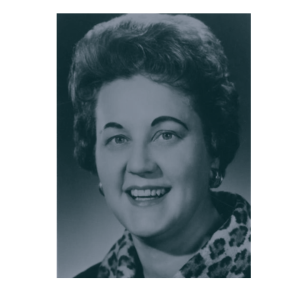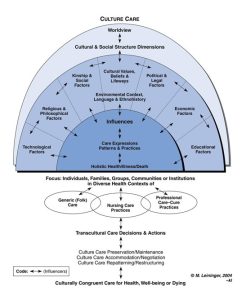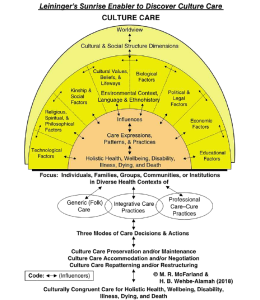3 Transcultural Nursing Theory: Madeleine Leininger
Learning Objectives
- Discuss SDOH and how SDOH impacts people where they live, work, and play.
- Discuss nurse theorist Madeleine Leininger’s Transcultural Nursing Theory
- Describe the nurse’s role in the provision of person-centered care to promote health equity
Transcultural Nursing Theorist: Madeleine Leininger
Figure 3-1 Madeleine Leininger (July 13, 1925 – August 10, 2012)

Madeline Leininger’s Transcultural Nursing Theory focuses on providing culturally congruent care, which is care that is beneficial, satisfying, and meaningful to individuals, families, and communities (Jeffries, M. & Zucha, R., 2018). The theory emphasizes that care (caring) is essential for well-being, health, healing, growth, survival, and facing handicaps or death (McFarland & Eipperle, 2015). It is the broadest holistic means to understand, explain, interpret, and predict nursing care phenomena (McFarland & Eipperle, 2015).
Leininger stresses that all caring is human caring and that care without a cultural perspective is meaningless. It is essential to listen to clients and understand their story and their own (emic) care knowledge first, before presenting (etic) professional knowledge (McFarland & Eipperle, 2015). This approach of mutual understanding and co-participation is vital to provide culturally congruent care.
Leininger’s theory recognizes the importance of social determinants of health by emphasizing that quality of life is a culturally constituted phenomenon that is shaped by the values, beliefs, symbols, and patterned expressions of cultural groups and individuals. Understanding these cultural meanings and values about quality of life is essential to provide care that truly promotes well-being (McFarland & Eipperle, 2015).
Figure 3-2
Madeleine Leininger’s Sunrise Model

Note: Leininger, M. (2004).
To achieve culturally congruent care, nurses need to be aware of, and sensitive to:
- communication barriers
- lack of knowledge about different cultural ways and beliefs
- feelings of ineffectiveness in delivering holistic care
Nurses who develop positive relationships with patients from diverse backgrounds note that it takes patience and time to build these relationships (Leininger, 2021). The theory encourages nurses to see themselves as cultural brokers and change agents in meeting the needs of diverse communities.
Leininger’s theory underscores that transcultural nursing requires more than just the application of the scientific method. Rather, it necessitates a deep understanding of different cultural ways of knowing and a willingness to embrace a variety of scientific methods that acknowledge and respect these diverse perspectives (Leininger, 2021).
Cultural competence is a multidimensional learning process that integrates transcultural skills in the cognitive, practical, and affective dimensions (McFarland & Eipperle, 2015). Leininger’s theory and the concept of cultural competence call for:
- Prioritized, formal, informal, and ongoing transcultural education to develop the necessary knowledge, skills, and values for nurses to achieve cultural congruence.
- Attention to verbal and non-verbal behaviors that demonstrate respect for the client’s cultural background.
- Incorporation of the Bill of Rights for Mixed Heritage Persons in organizational literature to foster an inclusive and culturally competent environment (Root, M. P., 1994; Jeffries & Zucha, 2018).
Transcultural Nursing and the Implication for Humanizing Healthcare
Madeleine Leininger’s Transcultural Nursing Theory has deep implications for humanizing healthcare, especially as technology becomes increasingly prevalent (McFarland & Wehbe-Alamah, 2019). The theory emerged from Leininger’s observations of the Gadsup people in Papua New Guinea, where she realized the critical link between culture and care. The theory highlights the profound impact of culture on health and well-being, advocating for a patient-centered approach that considers the individual’s social structure dimensions such as religion, kinship, and economic factors (McFarland & Wehbe-Alamah, 2019).
Leininger’s theory reminds us that all caring is human caring and that the art of nursing is inseparable from cultural understanding. It underscores the importance of viewing care from both emic (insider) and etic (outsider) perspectives (McFarland & Wehbe-Alamah, 2019). Nurses need to be attentive to patients’ stories, genuinely listen, and be open to their unique cultural knowledge and practices.
Key Concepts of Leininger’s Theory:
Culture Care: The synthesized knowledge of culture and care is used to discover and understand health, well-being, and ways of life.
Culturally Congruent Care: Using culturally based knowledge, actions, and decisions to fit the cultural values, beliefs, and lifeways of clients for their well-being.
Sunrise Enabler: A visual tool that guides nurses to consider the various social structure dimensions impacting a patient’s healthcare experience (McFarland & Wehbe-Alamah, 2019).
Figure 3-3
Sunrise Enabler

Note: (McFarland & Wehbe-Alamah, 2019, p. 543)
Three Modes of Culture Care Decisions and Actions: Provide a framework for integrating cultural knowledge into care practices:
- Culture Care Preservation/Maintenance: Supporting existing beneficial cultural care values and practices.
- Culture Care Accommodation/Negotiation: Helping patients adapt to or negotiate with others for safe and effective care.
- Culture Care Repatterning/Restructuring: Working with patients to reorder, change, or modify lifeways for better health outcomes (McFarland & Wehbe-Alamah, 2019).
Ways of Knowing and Being
Leininger argued against the limitations of relying solely on the scientific method, advocating for the inclusion of diverse scientific approaches that acknowledge and respect different cultural ways of knowing (McFarland & Wehbe-Alamah, 2019). She critiqued the overemphasis on “evidence-based” knowledge, pointing out that it often overlooks the human element essential for culturally congruent care (McFarland & Wehbe-Alamah, 2019).
Implications for Humanizing Healthcare:
Counteracting the Dehumanizing Effects of Technology: Leininger’s theory emphasizes the human element in healthcare. By acknowledging the patient’s social and cultural context, the theory promotes holistic care that extends beyond the physical body (McFarland & Wehbe-Alamah, 2019).
Strengthening the Nurse-Patient Relationship: Active listening, empathy, and recognizing the patient as an individual are essential for fostering a genuine connection, especially in technology-driven settings (McFarland & Wehbe-Alamah, 2019).
Empowering Patients through Co-Participation: By incorporating patients’ cultural values and preferences, nurses can co-create care plans that are meaningful and acceptable, empowering patients in their healing journey.
Leininger’s Transcultural Nursing Theory offers a powerful framework for humanizing healthcare. By promoting the art of nursing, patient-centered care, and a deep understanding of culture, the theory guides nurses to be cultural brokers (McFarland & Wehbe-Alamah, 2019) who bridge the gap between technology and human connection. This approach is crucial for ensuring that healthcare remains focused on the individual’s well-being and respects their unique cultural identity.
Glossary
Culturally Congruent Care: Care that is beneficial, satisfying, and meaningful to individuals, families, and communities. It considers cultural values, beliefs, and lifeways.
Culture Care: The use of synthesized knowledge about culture and care to understand health, well-being, and ways of life.
Culture Care Accommodation/Negotiation: Helping patients adapt to or negotiate with others for safe and effective care.
Culture Care Preservation/Maintenance: Supporting existing beneficial cultural care values and practices.
Culture Care Repatterning/Restructuring: Working with patients to reorder, change, or modify lifeways for better health outcomes.
Emic Perspective: The insider’s or the patient’s perspective on health, illness, and care.
Etic Perspective: The outsider’s or the professional’s perspective on health, illness, and care.
Social Determinants of Health (SDOH): The conditions in the environments where people are born, live, learn, work, play, worship, and age that affect a wide range of health, functioning, and quality-of-life outcomes and risks.
Sunrise Enabler: A visual tool that guides nurses to consider the various social structure dimensions impacting a patient’s healthcare experience.
Transcultural Nursing: A subfield of nursing that focuses on the comparative study of cultures to understand similarities (cultural universals) and differences (cultural specifics) in relation to human care, health, and illness.
NCLEX Practice Questions
Question 1
A nurse is caring for a patient who immigrated from a different country. The patient is refusing pain medication after surgery. Which action by the nurse best demonstrates culturally congruent care according to Madeleine Leininger’s theory?
a) Administer the pain medication as prescribed, explaining that it is essential for recovery.
b) Ask the patient about their beliefs and practices regarding pain management in their culture.
c) Consult with a physician to order a different type of pain medication that might be more acceptable.
d) Encourage family members to persuade the patient to take the pain medication.
Question 2
Which of the following statements best describes Leininger’s concept of “emic” perspective in nursing care?
a) The nurse’s professional understanding of the patient’s health condition.
b) The patient’s own understanding and beliefs about their illness and treatment.
c) The use of scientific evidence to guide nursing interventions.
d) The application of universal nursing practices regardless of cultural differences.
Question 3
According to Leininger’s Sunrise Model, which factor should a nurse primarily consider when providing culturally congruent care?
a) The patient’s age and gender.
b) The availability of healthcare resources.
c) The patient’s social structure dimensions, such as religion and kinship.
d) The nurse’s own cultural background and beliefs.
Question 4
Which nursing action is an example of “culture care accommodation/negotiation,” according to Leininger’s theory?
a) Encouraging a patient to continue their traditional healing practices alongside prescribed medical treatment.
b) Providing educational materials about the patient’s health condition in their native language.
c) Respecting a patient’s decision to refuse a blood transfusion due to religious beliefs.
d) Modifying a patient’s diet plan to incorporate culturally preferred foods.
Question 5
What is the primary goal of transcultural nursing, according to Leininger?
a) To eliminate all cultural differences in healthcare settings.
b) To provide care that fits the patient’s cultural values, beliefs, and lifeways.
c) To ensure that all patients receive standardized medical treatments.
d) To promote the adoption of Western medical practices globally.
Question 6
Which statement by a nursing student demonstrates a good understanding of Leininger’s theory?
a) “Culture has little impact on a person’s health beliefs and practices.”
b) “It’s important to treat all patients the same, regardless of their culture.”
c) “Scientific evidence is the only valid basis for nursing interventions.”
d) “Understanding a patient’s cultural background is essential for providing holistic and effective care.”
References:
Jeffreys, M. R., & Zoucha, R. (2018). Cultural congruence in the workplace, health care and academic settings for multiracial and multiheritage individuals. Journal of Cultural Diversity, 25(4), .https://research-ebsco-com.lynx.lib.usm.edu/c/wvb5o2/viewer/pdf/z4h5myboif
Leininger, M. (2001). Founder’s focus: Types of sciences and transcultural nursing knowledge. Journal of Transcultural Nursing, 12(4), 333–336. https://pubmed.ncbi.nlm.nih.gov/11989225/#:~:text=PMID%3A%2011989225-,DOI%3A%2010.1177/104365960101200411,-No%20abstract%20available
McFarland, M. R., & Eipperle, M. K. (2015). Application of the three modes of culture care decisions and actions. In M. R. McFarland & H. B. Wehbe-Alamah (Eds.), Culture care diversity and universality: A worldwide nursing theory (3rd ed., pp. 329–343). Jones & Bartlett Learning.
McFarland, M. R., & Wehbe-Alamah, H. B. (2019). Leininger’s theory of culture care diversity and universality: An overview with a historical retrospective and a view toward the future. Journal of transcultural nursing : official journal of the Transcultural Nursing Society, 30(6), 540–557. https://journals.sagepub.com/doi/10.1177/1043659619867134#:~:text=https%3A//doi.org/10.1177/1043659619867134
Root, M. (1994). Bill of Rights for People of Mixed Heritage. https://www.apa.org/pubs/videos/4310742-rights.pdf

